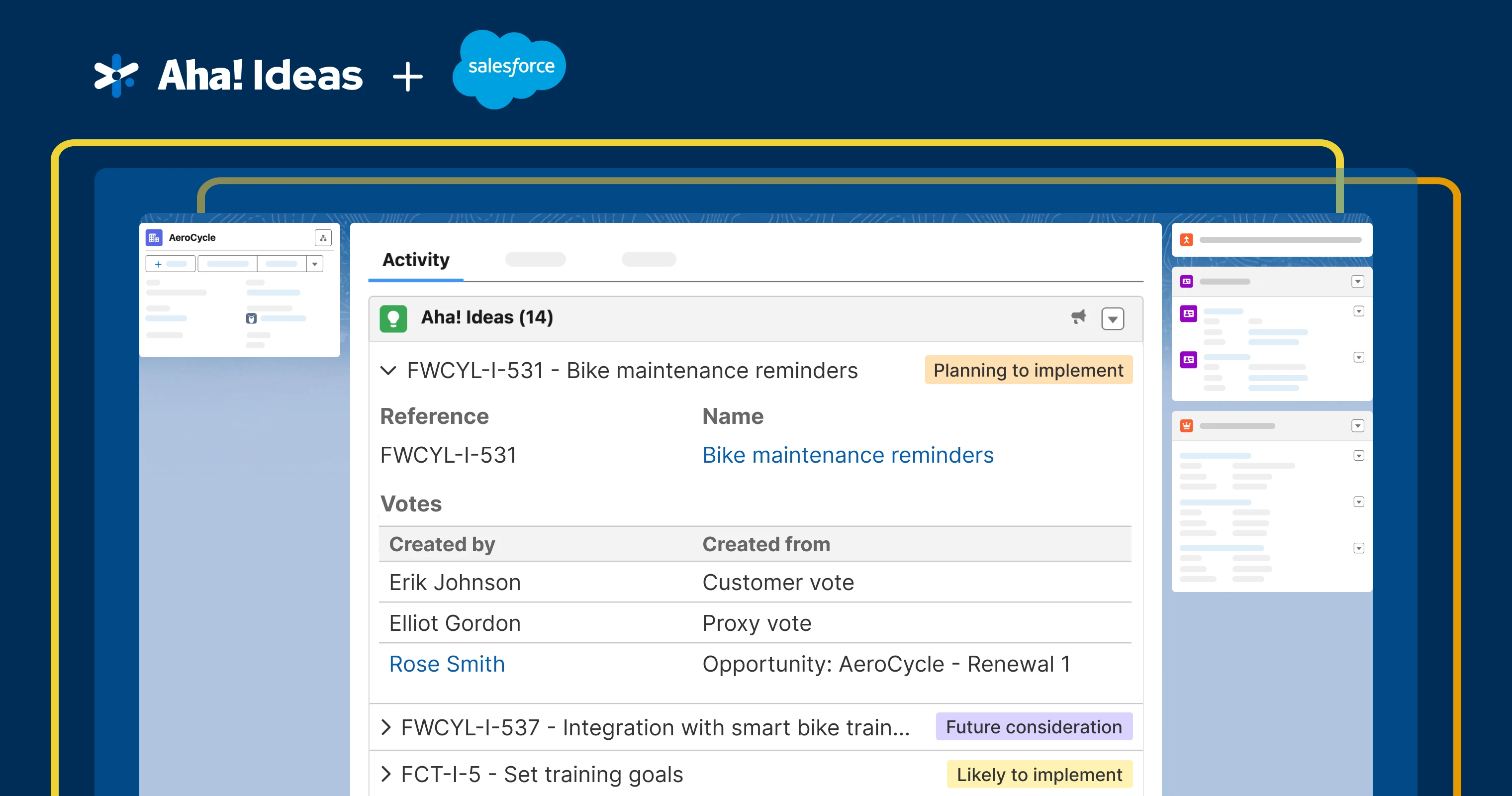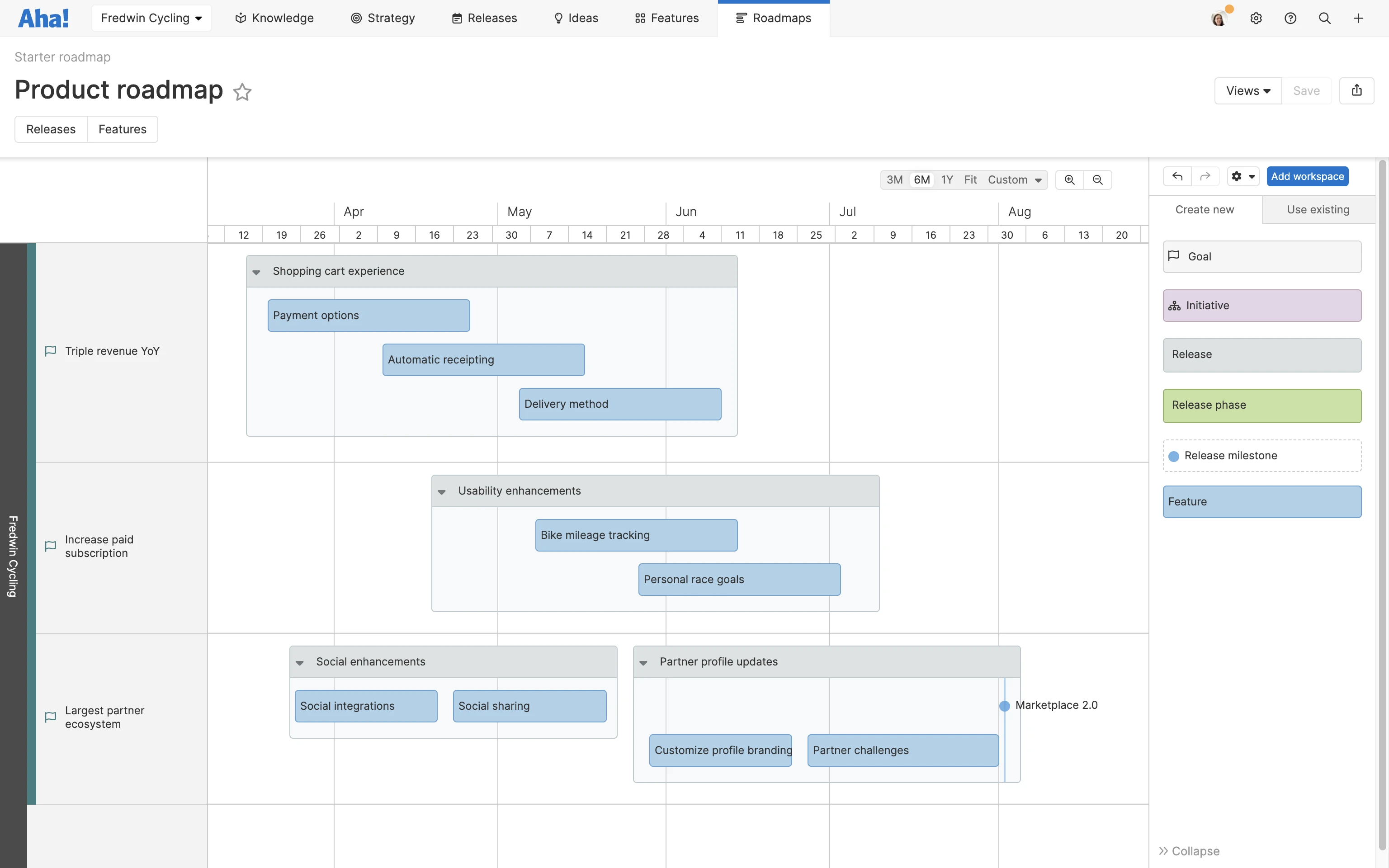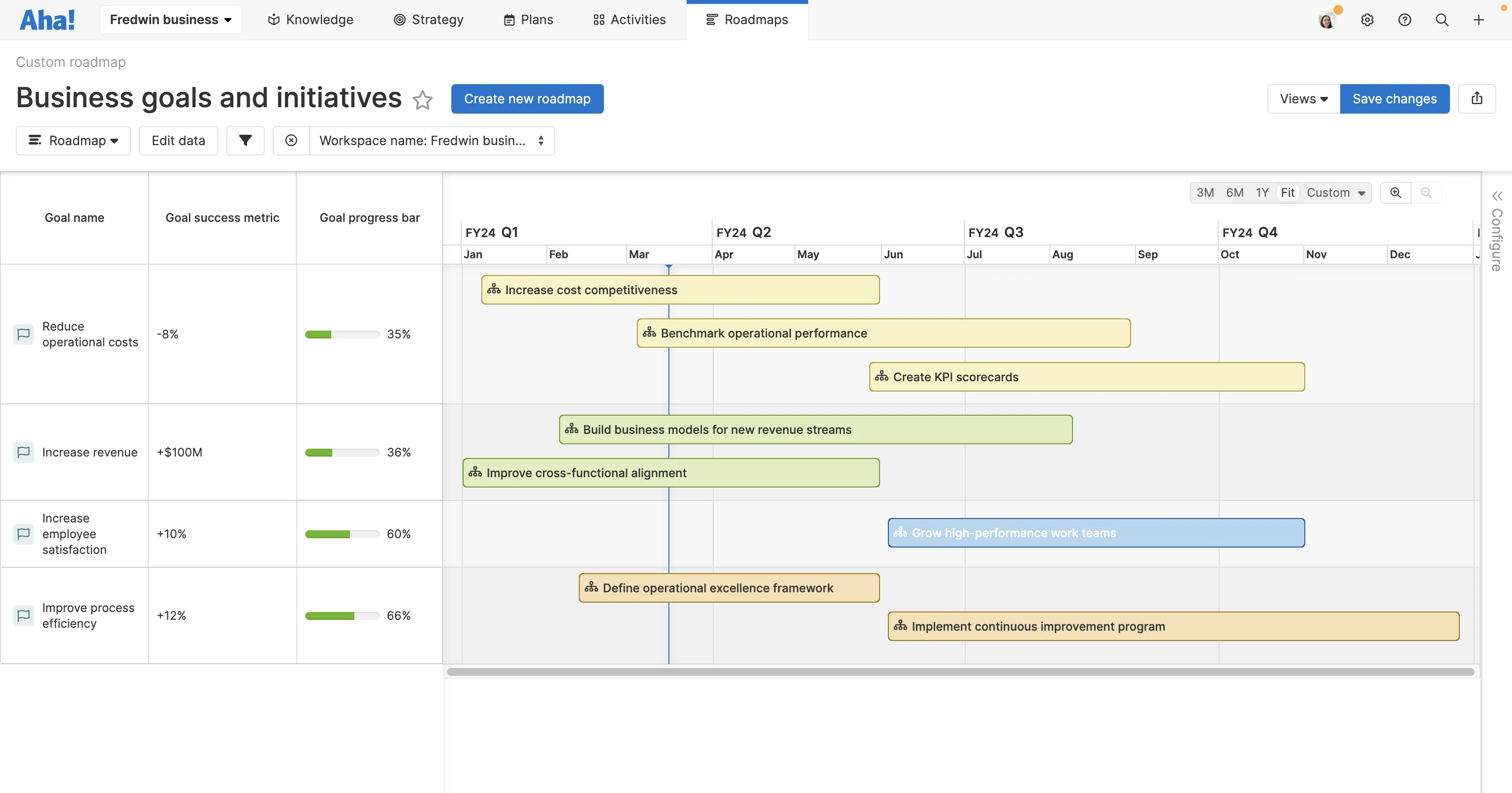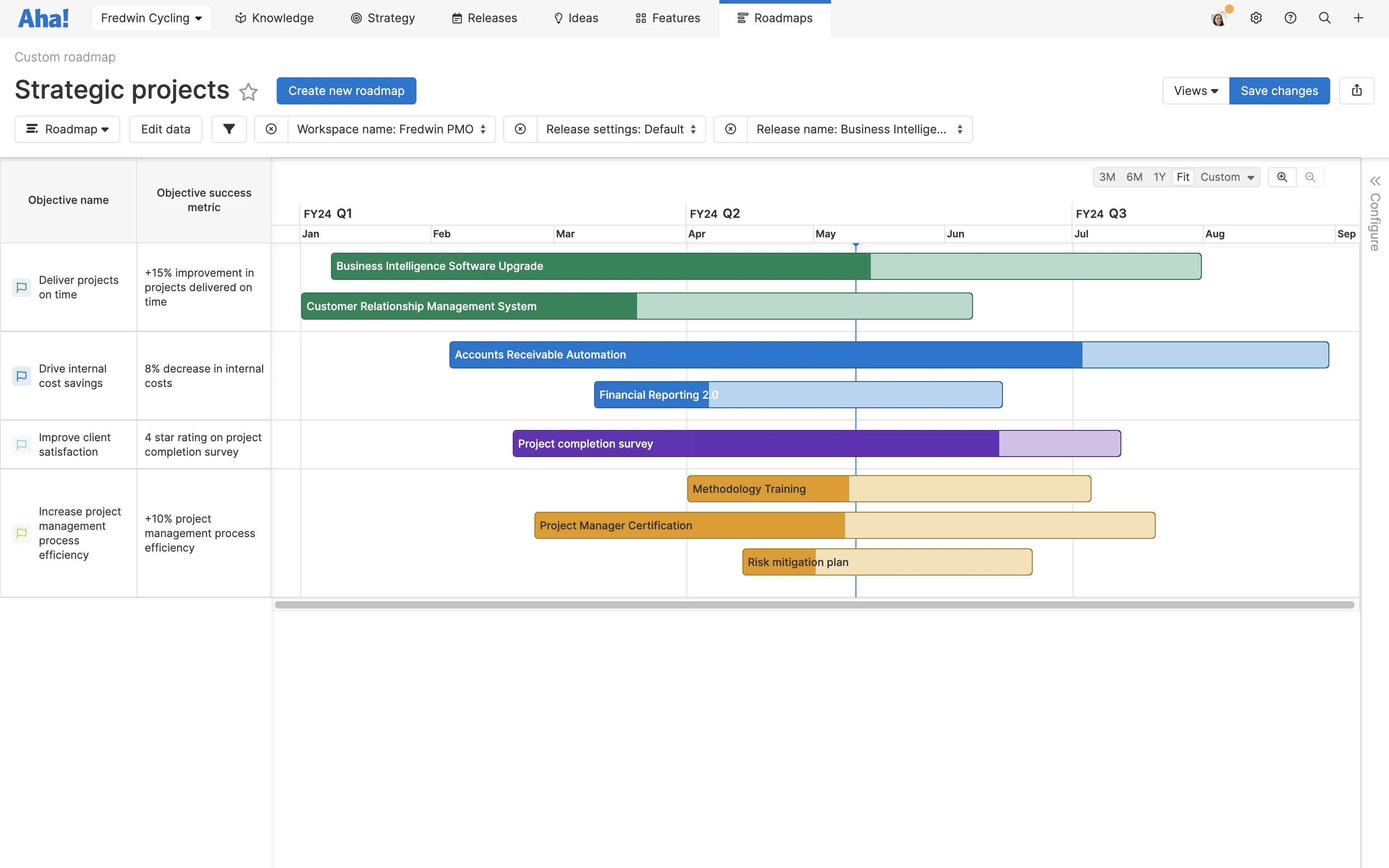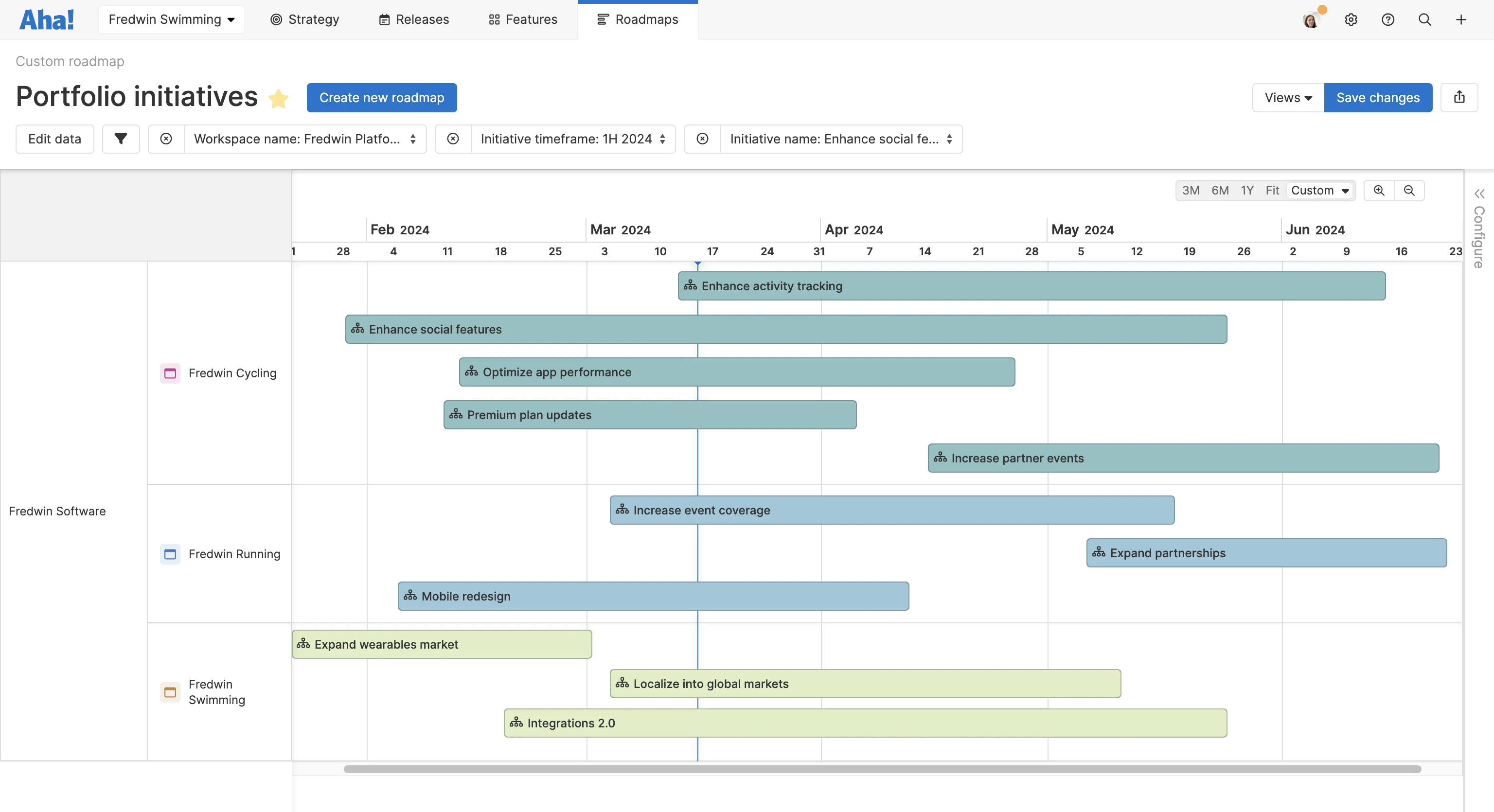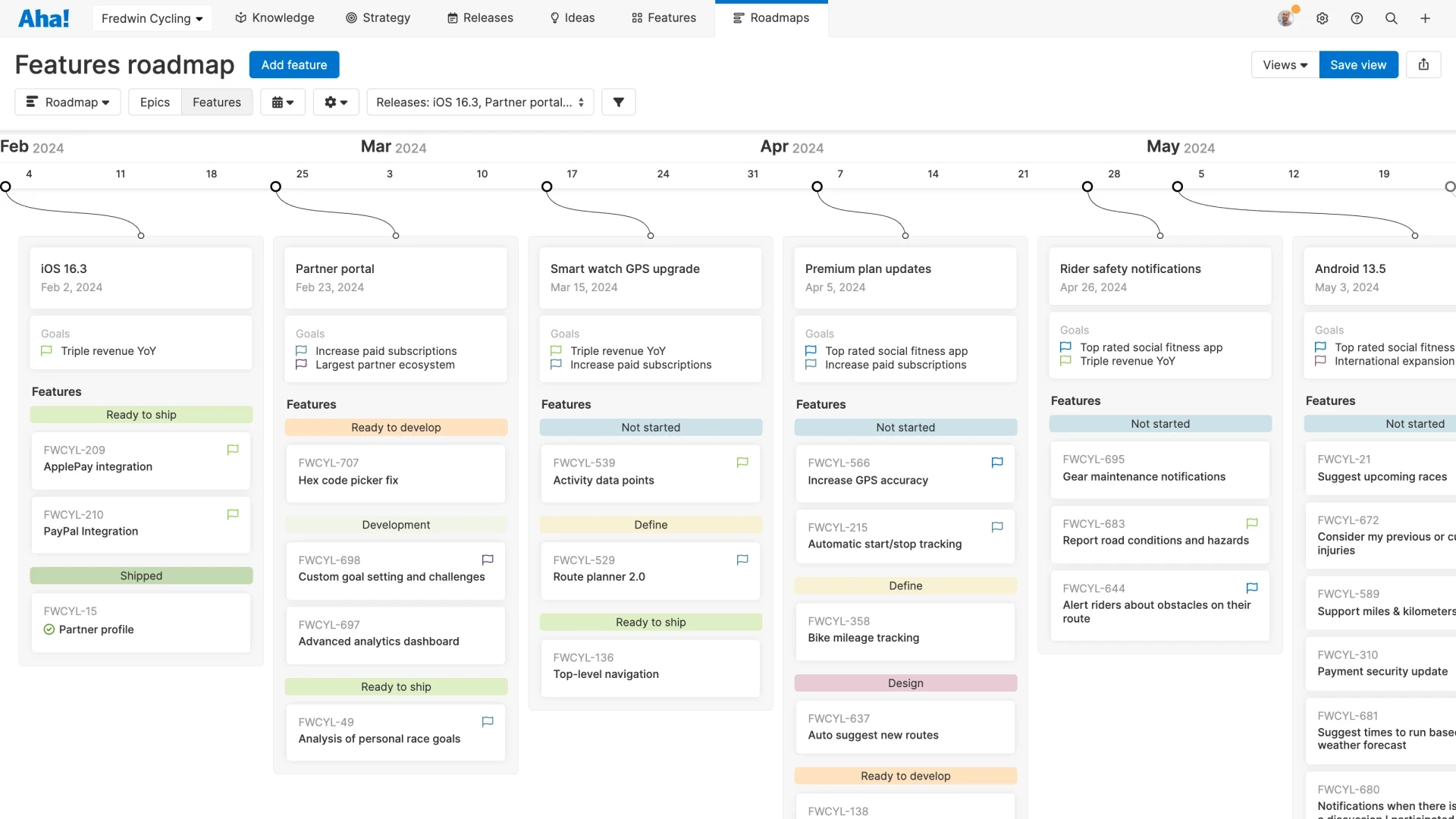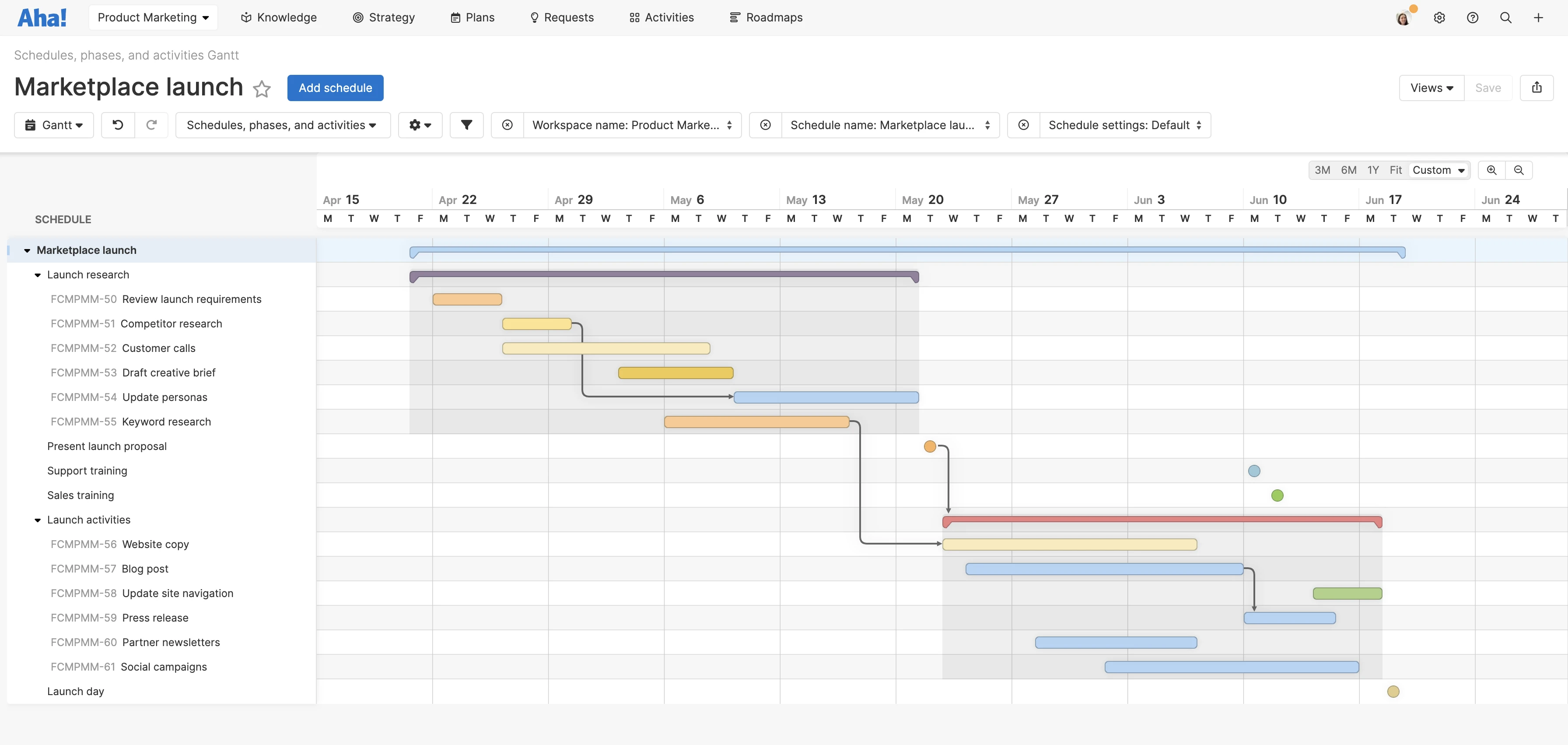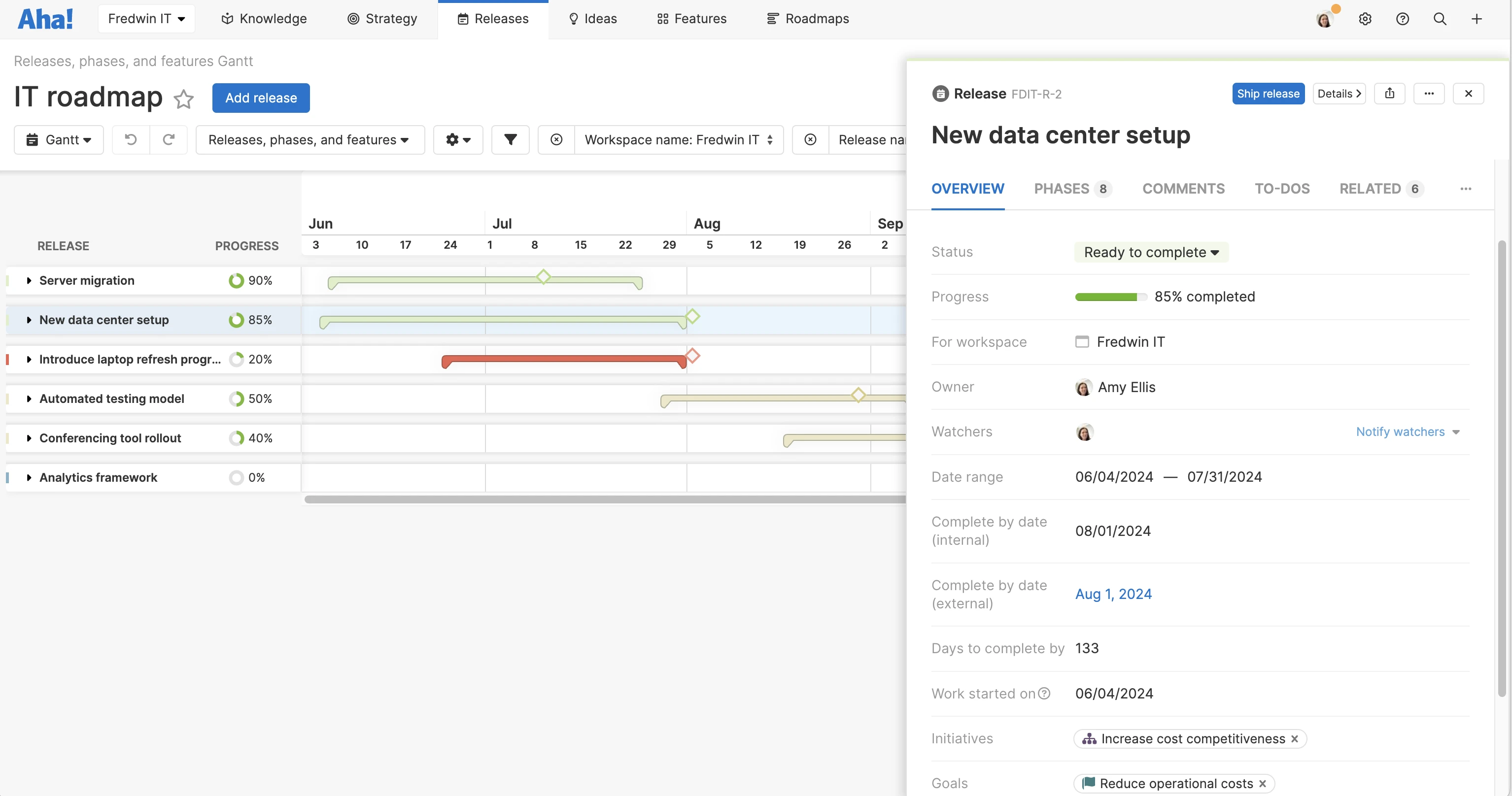Who uses a roadmap?
Gone are the days when product development teams were the only ones using roadmaps. Managers across a variety of cross-functional groups roadmap to help their team understand what is coming next and who is responsible. For example:
Executives use business roadmaps to communicate companywide goals and strategic efforts.
IT managers create technology roadmaps to visualize improvements to existing infrastructure, architecture, and technology processes.
Project managers rely on project roadmaps to communicate a timeline for project goals, tasks, and assignments.
Product managers maintain product roadmaps that focus on communicating the product vision and putting plans into action.
Marketing managers build marketing roadmaps to align groups around integrated marketing plans and all related activities.
Because roadmaps provide a high-level overview of strategy, timing, and feature work, many internal (and even external) stakeholders might reference the team's roadmap to quickly understand how the activities included support the company's goals and initiatives.
Top
Core roadmapping concepts
The details can vary, but the basic components of a roadmap do not change. All roadmaps should answer the following questions:
Why are we doing this?
What exactly are we doing?
When are we doing this?
By including strategic information, time frames, and prioritized work, your roadmap can provide the clarity needed to move ahead. Here are a few common elements:
Goals and initiatives: Show the value that your work brings and how it delivers on business objectives
Releases and milestones: Answer the question of when work will start and be delivered to market
Epics and features: Communicate committed work prioritized by overall value
Dependencies: Visualize interrelated work that might impact delivery
Top
Benefits of creating a roadmap
A roadmap is a promise of what you will deliver, not how you will deliver it. This forces you to be judicious about what you choose to commit to. When each work item clearly aligns with your overall objectives, you can be confident that you are investing your time wisely. Only include the initiatives and tasks that are most important for achieving your goals.
Everyone can benefit from building and referencing a roadmap. Here is how:
Accountability | Company leaders, teammates, and customers count on you. Roadmaps share what you will deliver and when so everyone can follow through on the plan. |
Alignment | You cannot achieve anything meaningful in a vacuum. Roadmaps align different teams, portfolios, or areas of the business so that everyone understands the vision and objectives. |
Clarity | What are you working toward and why? Roadmaps clarify strategic goals and link work to that strategy, ensuring teams can focus on the activities that bring you closer to your goals. |
Communication | Transparency is key. Roadmaps display plans to show direction, visualize timing, anticipate challenges, and drive conversations with teammates. |
Coordination | Large or complex projects require collaboration among multiple groups within an organization. Roadmaps help you track dependencies and identify bottlenecks to ensure that you deliver on time. |
Related:
Top
5 common roadmapping misconceptions
Despite the growing popularity of roadmaps, there are still many points of confusion about what a roadmap actually is and what it is not. Some of the most prevalent misconceptions about roadmaps include:
"A roadmap is a to-do list": Some people think of a roadmap as a list of upcoming tasks or (in the context of product development teams) a backlog. Although you can use a roadmap to guide prioritization decisions and inform what to work on next, a roadmap is a distinct document. Keeping your roadmap separate from other planning materials — such as backlogs or customer requests — helps you maintain your strategic focus.
"Roadmaps should not change": It is true that a roadmap is a commitment. It captures what you will work toward over the next quarter, six months, year, or longer. But because you typically create a roadmap at the beginning of your planning process, priorities might shift. Adjust dates and details when necessary.
"Roadmaps replace Gantt charts": Teams that follow agile software methodology might think of a Gantt chart as a waterfall artifact. The reality is that roadmaps and Gantt charts can be valuable (and often complementary). In a roadmap tool like Aha! Roadmaps, you can enter data once — from high-level strategy to more detailed work. Then, you can customize your view to display both a strategic roadmap and a detailed Gantt chart that captures phases of work, tasks, milestones, and dependencies.
"A roadmap will slow agile teams down": Some agile folks think that a roadmap with dates will keep them from continuously iterating and delivering. In fact, roadmaps can make you more efficient. A roadmap aligns everyone on the team around the goals and plans, providing a clear direction and a way to quickly view priorities. The roadmap is your foundation — it is the "why" behind the "how."
"A roadmap must have exact dates": If roadmaps are visual timelines, and then including exact dates is a must, right? Not quite. Although some teams commit to delivering on specific days, others choose to plan in broader time frames: weeks, months, or quarters. A time-based roadmap gives you checkpoints to make sure the work you have committed to is progressing.
Related:
Top
8 top roadmapping examples
There is no "correct" look for a roadmap. How you build your roadmap depends on the information you are communicating, the level of detail you want to show, and your audience. For example, some roadmaps convey high-level info such as key initiatives, while others drill down on the details of activities in a specific timeline.
The best roadmaps give you a clear view of the duration of work items such as goals, themes of work, and activities. Successful roadmaps vary in appearance, but they are all:
Here are eight examples of roadmaps for product, product marketing, and IT teams — all built using Aha! Roadmaps, our purpose-built roadmap software:
Business roadmap
Strategic roadmap
Portfolio roadmap
Features roadmap
Agile roadmap
Go-to-market roadmap
Marketing roadmap
Technology roadmap
1. Business roadmap
A business roadmap shows the most important strategic efforts across the company. These are typically created by executives and then shared with functional teams to inform their own roadmaps. Business roadmaps usually sync with an organization's strategic planning process. We follow The Aha! Framework for product development, which calls for this planning and corresponding roadmap on a semiannual basis. But that schedule could be different depending on your chosen methodology or framework.
Each initiative ties to a business goal and success metric. Progress bars show how close the team is to achieving the goals.
If you want to get started quickly, try adding your business goals to our Now, Next, Later roadmap template. You can capture your initiatives in the left-side column of the template and fill in short- and longer-term plans. Once the team reviews and provides feedback, convert elements on the whiteboard template directly into work items in Aha! Roadmaps.
2. Strategic roadmap
A strategic roadmap visualizes high-level goals and initiatives. In this example, you can see progress against releases that serve specific goals. The timeline at the top gives a sense of when the team plans to deliver the work.
Releases on this strategic roadmap are clickable and can unfurl to show specific features and related dependencies.
You can also take a look at our strategic roadmap whiteboard template. Use it to capture the high-level initiatives you are working toward, along with timelines for when the team will deliver major efforts.
3. Portfolio roadmap
A portfolio roadmap shows planned releases across multiple groups or offerings. The bars below are in different colors to represent separate products.
Filters up top allow you to narrow in on the initiatives you want to view.
With our portfolio roadmap template, you can display a comprehensive view of your plans and areas of investment alongside a timeline for delivery.
4. Features roadmap
A features roadmap shows all work in flight for a given time period. You might see vertical columns or swimlanes to indicate different releases. Note that each release corresponds to a time frame, so it is easy to see when you plan to deliver.
The status of each feature is labeled ("Not started," "Ready to develop," "Shipped," etc.)
Our features roadmap template makes it easy to zoom in on the details of what is coming and when. Link each feature to the strategic initiatives and use colors and progress bars to represent work's status.
Related:
5. Agile roadmap
An agile roadmap shows major themes of work on a general timeline. Those themes could be product goals or epics, or groups of related features. The date range will depend on how an agile development team works, but it is not common to see an agile roadmap expand beyond a quarter at a time. The flexibility of agile workflows makes it easier to keep the roadmap contained to just a few sprints or iterations.
Each of the columns shows a high-level epic that the development team is working on — along with key details such as corresponding goals and statuses.
Show what your agile team is working on with our epics roadmap template. This template is particularly helpful for guiding prioritization decisions about upcoming features and communicating when the team will deliver a group of related features.
Related:
6. Go-to-market roadmap
A go-to-market roadmap gives a complete picture of everything that must be done to accomplish a successful launch. The roadmap below includes cross-functional tasks and activities — from drafting a creative brief to conducting sales and support training. You can track dependencies (the arrows) and milestones (the dots) to make sure everyone delivers on time.
This example of a go-to-market roadmap was built by a product marketing team.
Check out our release roadmap template: a Gantt-style view of what the team must do to launch on time. Everyone on the broader team can see dates, dependencies, and key milestones as you prepare to deliver a new experience to customers.
7. Marketing roadmap
A marketing roadmap shows marketing goals and related activities that support overall business objectives. Depending on the complexity of the organization, you might have a marketing roadmap that separates work by function (such as digital marketing and content marketing) or one that visualizes major campaigns linked to specific products.
This roadmap shows how the strategic marketing initiatives map to the overall goals, along with a timeline for completion.
Before creating your marketing roadmap, organize your research and thoughts in this collection of marketing strategy templates. Write an executive summary, capture your marketing goals and success metrics, and include information about your customers and competitors. You can also conduct a SWOT analysis and begin filling in launches, campaigns, and other marketing activities on a calendar.
Related:
8. Technology roadmap
A technology roadmap is a visualization of strategic IT plans. Examples of focus areas that might go on a technology roadmap include updating infrastructure and platforms or managing a data transformation. A good technology roadmap usually includes goals and initiatives, new system capabilities, release plans, milestones, resources, training, risk factors, and status reports.
This example shows all the work the team must do to roll out new integrations. The window displays more information about the "New data center setup" release.
Related:
Top
How to choose roadmapping software
You can certainly create roadmap views in spreadsheets or presentation software, but the downsides to this approach are steep:
It can take hours to manually create even a simple roadmap in a tool not built for such a task.
Updating the roadmap means more manual work every time something changes.
Sharing your roadmap takes old-school effort — saving and attaching, converting file formats, linking, and managing document permissions.
Dynamic collaboration with teammates is difficult or impossible.
This is why many teams use purpose-built roadmap software like Aha! Roadmaps. Instead of constantly updating your roadmap or worrying about version control, you can quickly create, customize, and share beautiful views of your strategic plans. Simply build a roadmap and link it to the detailed work. Enter your information once, and your roadmap will update automatically — so everyone can see how they are making progress toward the goals in real time.
Ready to get started? Watch how it works — or try Aha! Roadmaps now.
